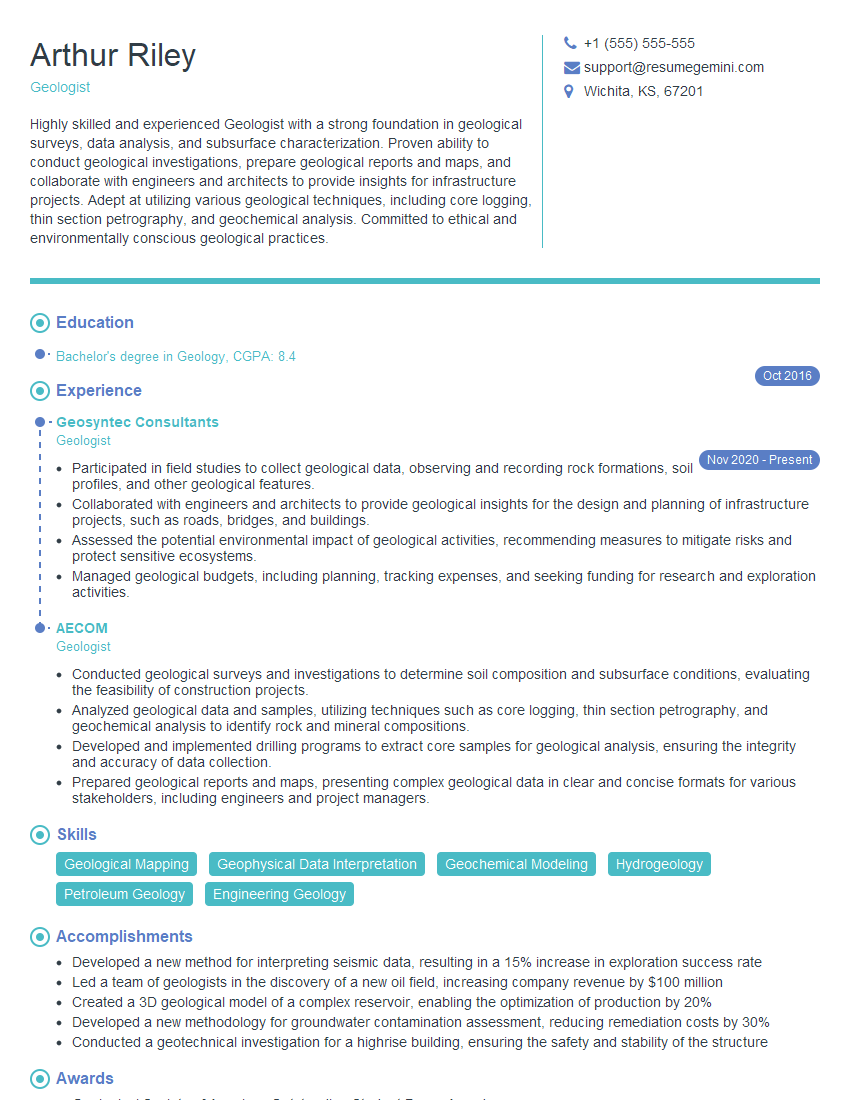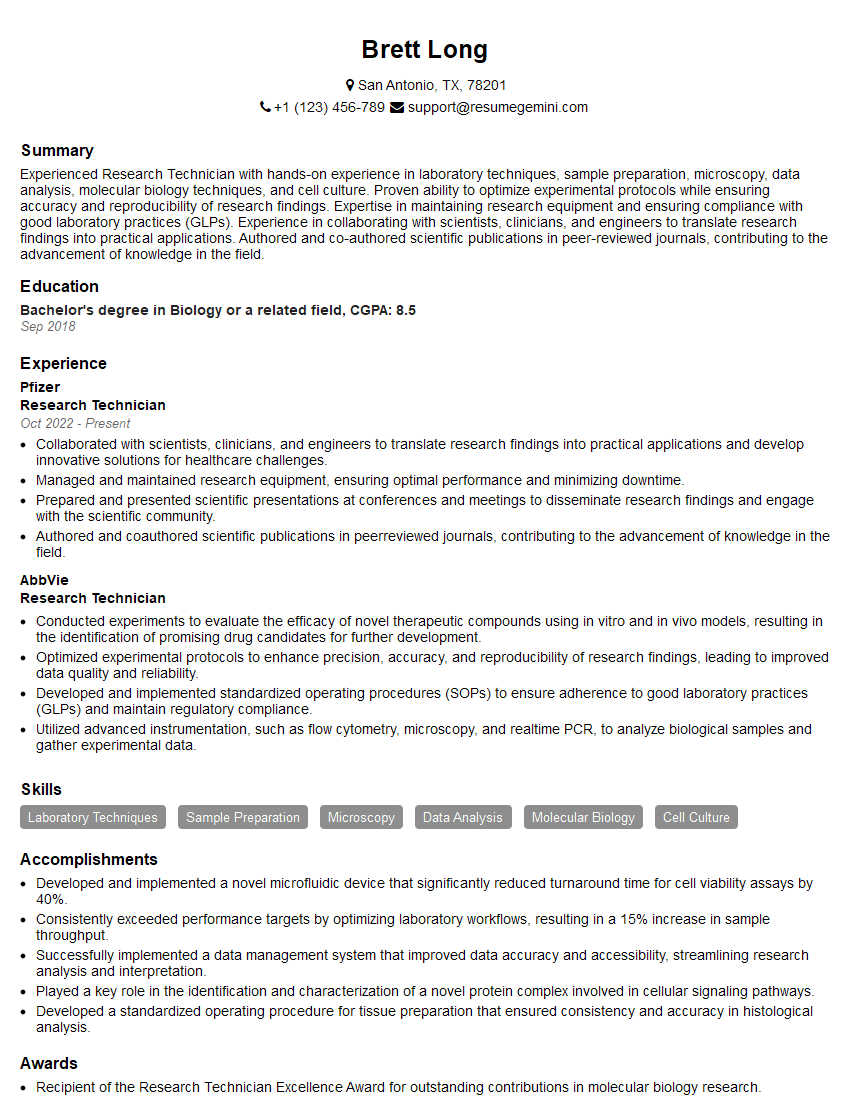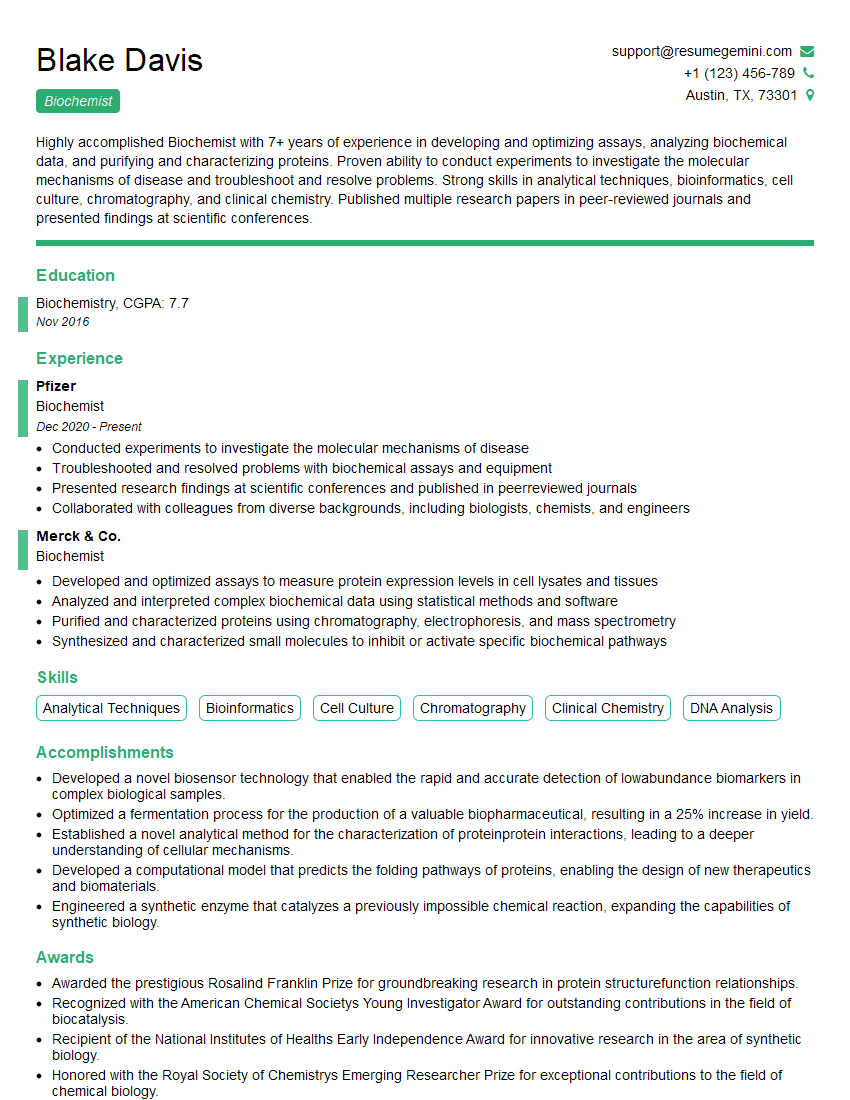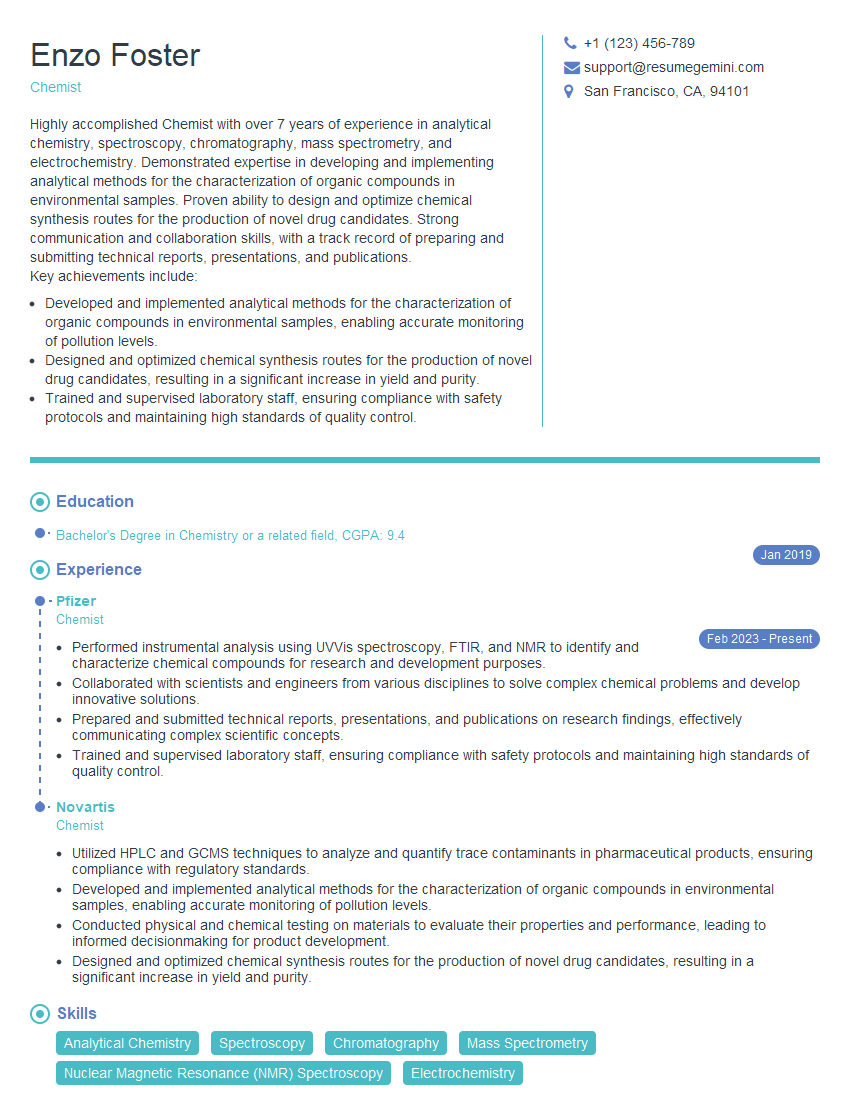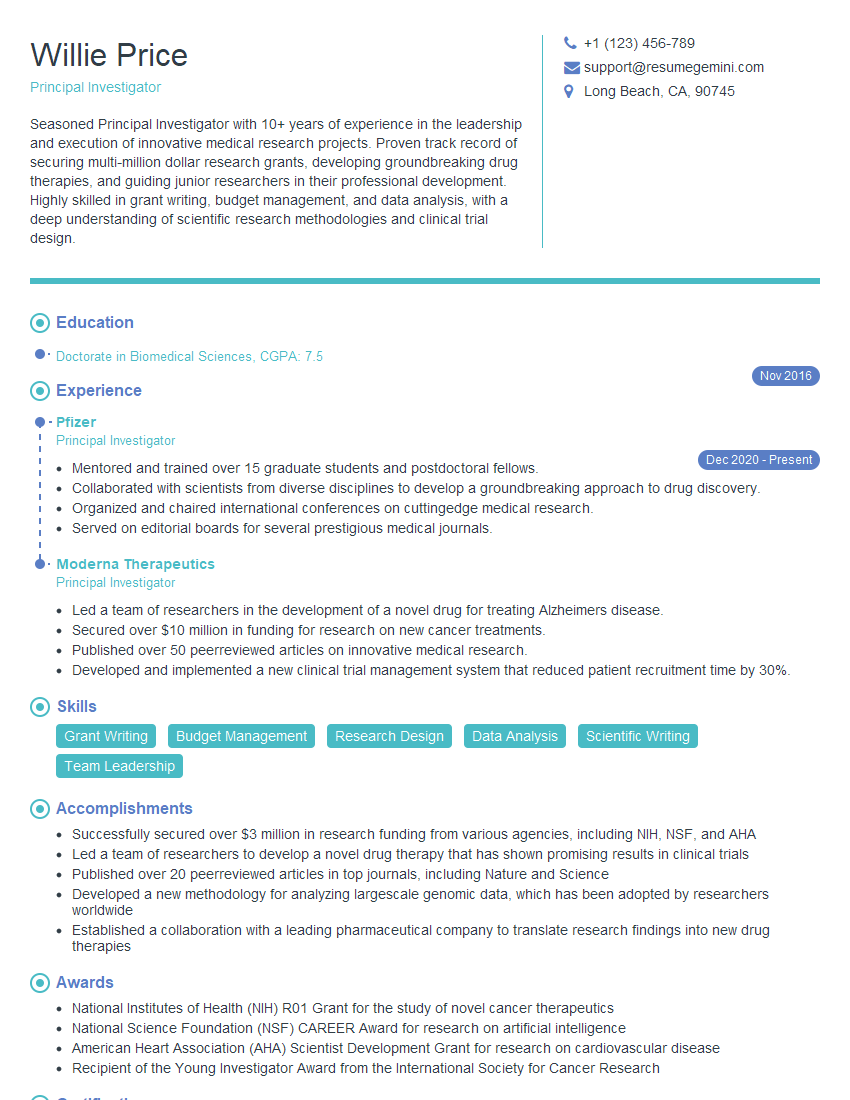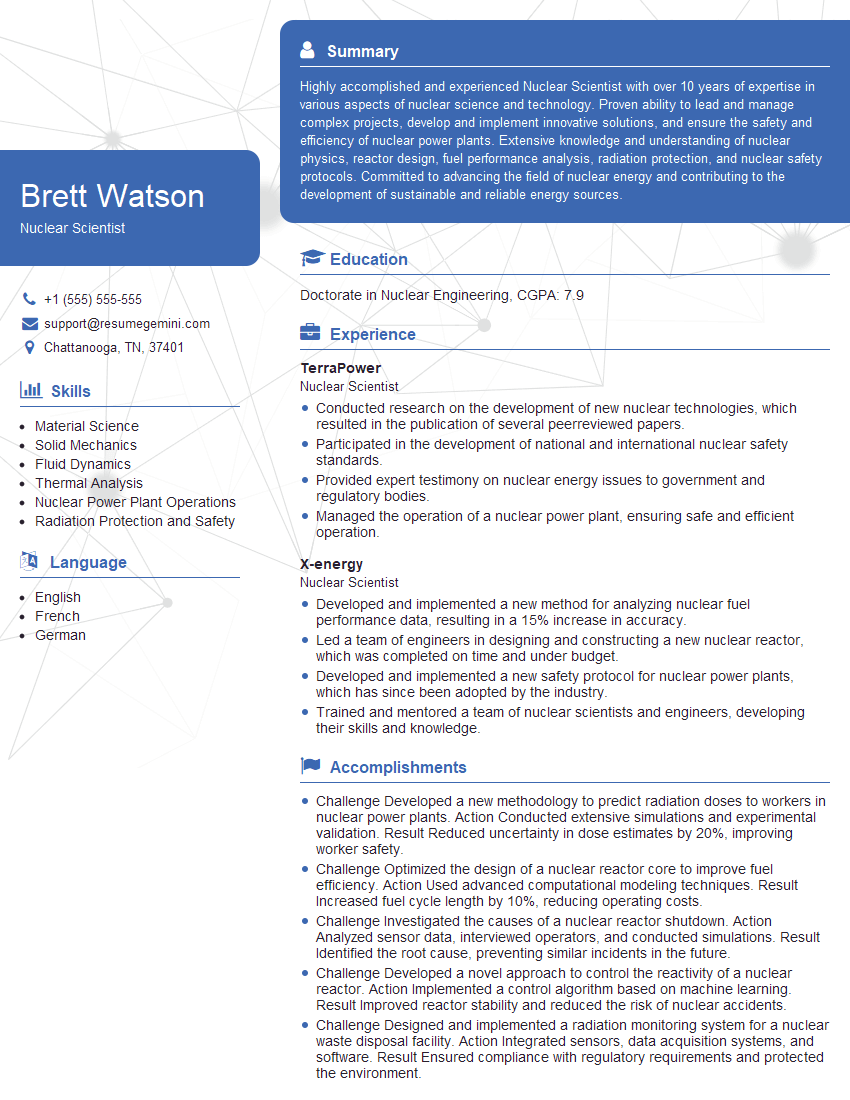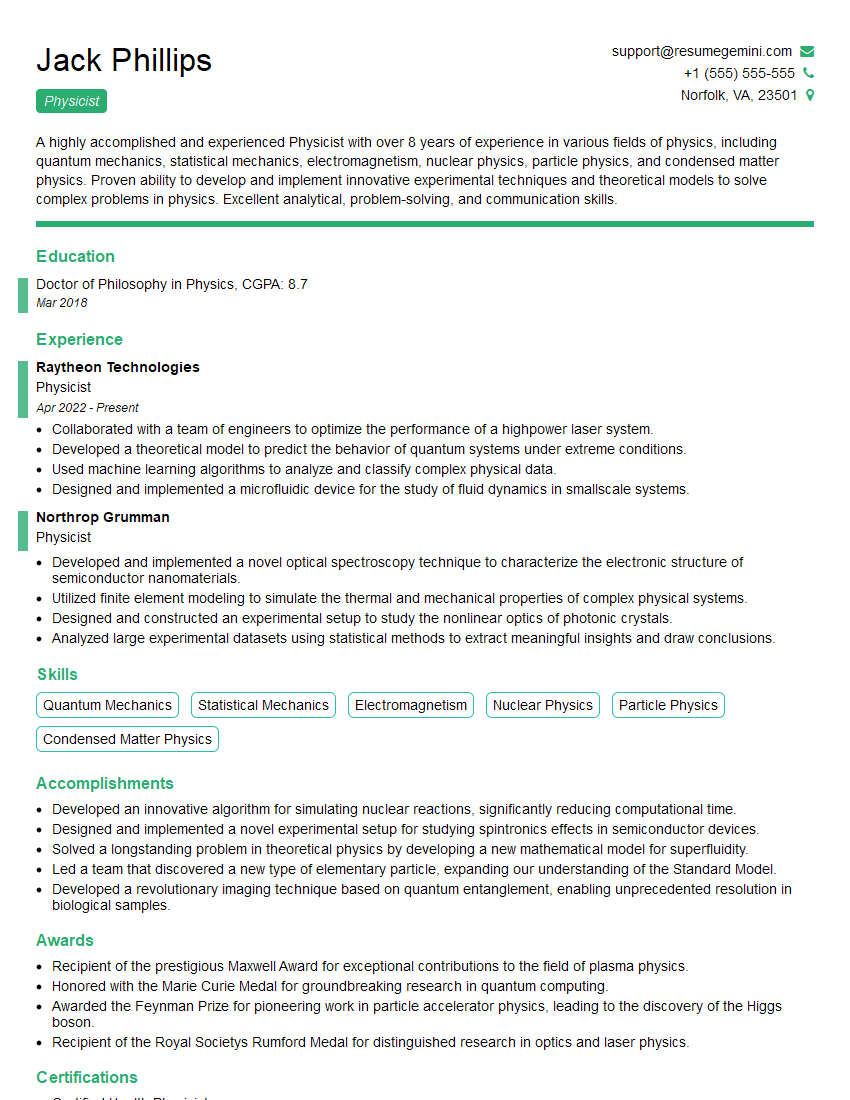Feeling uncertain about what to expect in your upcoming interview? We’ve got you covered! This blog highlights the most important Scientific Research and Exploration interview questions and provides actionable advice to help you stand out as the ideal candidate. Let’s pave the way for your success.
Questions Asked in Scientific Research and Exploration Interview
Q 1. Explain the scientific method in detail.
The scientific method is a systematic approach to investigating phenomena, acquiring new knowledge, or correcting and integrating previous knowledge. It’s a cyclical process, not a linear one, constantly refining our understanding.
- Observation: Noticing a phenomenon or problem. For example, observing that plants grow taller in sunlight.
- Question: Formulating a specific, testable question based on the observation. For instance, ‘Does the amount of sunlight affect plant growth?’
- Hypothesis: Proposing a tentative explanation (hypothesis) to answer the question. A testable hypothesis might be: ‘Plants exposed to more sunlight will grow taller than plants exposed to less sunlight.’
- Prediction: Making a specific, measurable prediction based on the hypothesis. ‘If plants are given more sunlight, then their height will increase proportionally.’
- Experiment: Designing and conducting a controlled experiment to test the prediction. This involves manipulating a variable (amount of sunlight) and measuring its effect on another variable (plant height), while keeping other factors constant (water, soil type etc.).
- Analysis: Analyzing the data collected from the experiment using statistical methods to determine if the results support or refute the hypothesis.
- Conclusion: Drawing conclusions based on the analysis. If the results support the hypothesis, it may be strengthened (but not proven true). If not, the hypothesis is revised or rejected, and the process begins again.
- Communication: Sharing the findings with the scientific community through publications or presentations. This allows for peer review and further investigation.
This iterative nature allows for continuous improvement and refinement of our understanding. A single experiment rarely provides definitive answers; rather, it contributes to a broader body of evidence.
Q 2. Describe your experience designing and conducting experiments.
My experience encompasses designing and conducting experiments across diverse fields, from studying the effects of microgravity on cell cultures to investigating the efficacy of novel drug delivery systems. In one project involving the effects of a new fertilizer on crop yield, I designed a completely randomized block design to control for soil variation. We divided a field into blocks, each containing plots with varying levels of the fertilizer, ensuring each fertilizer level was represented within each block. This minimized the impact of soil heterogeneity on our results. Data was meticulously recorded using calibrated instruments and detailed logs. The experiment involved multiple replicates to ensure statistical validity. Another example involved using a flow cytometer to analyze the effects of a new treatment on immune cell populations, requiring meticulous sample preparation and rigorous quality control protocols to maintain data integrity.
Q 3. How do you ensure the reproducibility of your research?
Reproducibility is paramount in scientific research. To ensure this, I meticulously document every step of my research process, from initial experimental design to data analysis. This includes:
- Detailed protocols: Clearly defined procedures with precise measurements and controls are crucial. These are often documented in laboratory notebooks and shared via collaborative platforms.
- Data management: Using version-controlled databases and repositories (e.g., GitHub, Figshare) to store all raw data, metadata, and analysis scripts. This makes it easy to track changes and share data transparently.
- Open-source tools: Employing open-source software for analysis whenever possible, promoting transparency and allowing others to verify results. Including code versions is especially important.
- Transparent reporting: Providing complete descriptions of methods, statistical analyses, and results in publications. This allows other researchers to scrutinize the methodology and replicate the study.
- Data sharing: Making data publicly available (where ethical and feasible) to facilitate verification and potential re-analysis by other researchers.
By implementing these practices, I strive to make my research readily reproducible, fostering trust and advancing the collective scientific knowledge.
Q 4. What statistical methods are you proficient in?
My statistical proficiency encompasses a wide range of methods, tailored to the specific research question and data type. I’m proficient in:
- Descriptive statistics: Calculating means, standard deviations, medians, and other summary statistics to describe data.
- Inferential statistics: Utilizing t-tests, ANOVA, regression analysis, and chi-squared tests to draw inferences from data and test hypotheses.
- Non-parametric methods: Employing methods like Mann-Whitney U test and Kruskal-Wallis test when assumptions of normality are violated.
- Survival analysis: Analyzing time-to-event data using Kaplan-Meier curves and Cox proportional hazards models, particularly relevant in biomedical research.
- Multivariate analysis: Utilizing techniques like principal component analysis (PCA) and cluster analysis to explore relationships within complex datasets.
I’m also familiar with statistical programming languages like R and Python, allowing me to perform advanced analyses and create visualizations.
Q 5. How do you handle conflicting data or unexpected results?
Conflicting data or unexpected results are not failures, but opportunities for deeper understanding. My approach involves a systematic investigation:
- Re-examination of the data: I meticulously check for errors in data collection, entry, and analysis. This might involve re-running analyses, reviewing laboratory notebooks, and validating data through independent methods.
- Review of experimental design: I evaluate whether the experimental design adequately addressed confounding variables or potential biases. This might lead to modifications for future experiments.
- Literature review: I examine existing literature to see if similar unexpected results have been reported. This can provide context and alternative explanations.
- Consultation with colleagues: Discussions with experts in relevant fields can offer fresh perspectives and help identify potential issues.
- Further experimentation: If necessary, I design and conduct additional experiments to address the inconsistencies or clarify the unexpected findings. This might involve changing the experimental conditions or focusing on specific aspects of the system.
Ultimately, the goal is to identify the source of the discrepancy and incorporate the new knowledge into a more complete and accurate understanding.
Q 6. Explain your experience with data analysis and visualization tools.
My experience with data analysis and visualization tools is extensive. I’m proficient in using:
- Statistical software: R, SPSS, and SAS for complex statistical analyses.
- Data visualization tools: ggplot2 (R), Matplotlib and Seaborn (Python), Tableau, and GraphPad Prism for creating informative and visually appealing graphs and charts.
- Programming languages: Python and R for data manipulation, analysis, and automation.
- Databases: SQL and NoSQL databases for managing and querying large datasets.
I understand the importance of choosing appropriate visualization techniques to effectively communicate findings to diverse audiences. For instance, I might use scatter plots to show correlations, box plots to compare groups, or heatmaps to visualize complex relationships within datasets.
Q 7. Describe a challenging research project you overcame.
One particularly challenging project involved developing a novel biosensor for detecting a rare protein biomarker. Initial attempts yielded inconsistent and unreliable results. The challenge stemmed from the protein’s low abundance and susceptibility to degradation. We overcame this through a multi-pronged approach:
- Optimization of the biosensor design: We systematically tested different probe molecules and signal amplification strategies to enhance sensitivity and specificity.
- Refinement of sample preparation techniques: We developed a new protocol to minimize protein degradation and maximize recovery during sample extraction and processing.
- Rigorous quality control: We implemented stringent quality control measures at each step of the process, from reagent preparation to data analysis.
- Collaboration with experts: We collaborated with materials scientists and protein chemists to address technical challenges related to the biosensor design and protein stability.
This project taught me the importance of perseverance, adaptability, and collaboration in tackling complex scientific problems. Ultimately, we successfully developed a highly sensitive and reliable biosensor, paving the way for earlier and more accurate diagnosis.
Q 8. How do you prioritize tasks in a fast-paced research environment?
Prioritizing tasks in a fast-paced research environment requires a strategic approach. I use a combination of methods, starting with a clear understanding of project goals and deadlines. This involves breaking down large projects into smaller, manageable tasks, each with its own deadline.
I then employ a prioritization matrix, often a modified Eisenhower Matrix (urgent/important), to categorize tasks. Urgent and important tasks get immediate attention, while important but not urgent tasks are scheduled. Less important tasks are delegated or eliminated if possible. Tools like project management software (e.g., Asana, Trello) are invaluable for visualizing tasks, deadlines, and progress.
For example, in a recent project involving multiple experiments and data analysis, I prioritized completing the critical experiments first to obtain baseline data. This allowed me to identify potential issues early and adjust the experimental design or analysis plan accordingly, ultimately saving time and resources.
Q 9. What is your experience with literature reviews and synthesis?
Literature reviews are fundamental to my research process. My approach involves a systematic search across multiple databases (PubMed, Web of Science, Scopus, etc.), using relevant keywords and Boolean operators to refine results. I don’t just read abstracts; I critically assess the methodologies, results, and conclusions of each study.
Synthesis goes beyond summarizing individual papers; it’s about identifying patterns, discrepancies, and gaps in the existing knowledge. I create thematic maps or conceptual frameworks to visually organize the information and identify key themes. This often involves creating tables comparing different studies’ methodologies, results, and conclusions to highlight similarities and differences. For example, while researching the effects of a particular drug, I identified three studies with conflicting results. By analyzing their methodologies, I was able to pinpoint a flaw in one study’s design that likely accounted for the discrepancy, allowing me to draw a more informed conclusion.
Q 10. How do you manage your time effectively during research projects?
Effective time management in research is crucial. I utilize time-blocking techniques, scheduling specific blocks of time for particular tasks. This prevents task-switching and promotes focused work. I also incorporate regular breaks to maintain concentration and prevent burnout. The Pomodoro Technique (working in focused bursts with short breaks) has been particularly helpful.
I also prioritize minimizing distractions. This includes turning off notifications, scheduling dedicated email-checking times, and communicating my availability to colleagues to minimize interruptions. Furthermore, I regularly review my schedule and adjust it as needed, learning to anticipate potential delays and adjust my plans proactively. For instance, if an experiment takes longer than anticipated, I adjust my schedule to accommodate the delay without derailing the entire project.
Q 11. Describe your experience with grant writing or proposal development.
I have extensive experience in grant writing and proposal development. I understand the importance of clearly articulating the research problem, the proposed methodology, and the expected outcomes. A well-structured proposal needs a compelling narrative that highlights the significance of the research and its potential impact.
My approach involves thoroughly researching funding opportunities to identify the best fit for my research. I meticulously follow the guidelines and formatting requirements of each funding agency. I also collaborate with colleagues to ensure a strong team and a robust research plan. For instance, in securing a grant for a study on climate change, we had to carefully demonstrate the project’s relevance to the agency’s priorities, providing detailed budgets and timelines that met their stringent requirements.
Q 12. How familiar are you with ethical considerations in research?
Ethical considerations are paramount in research. My understanding encompasses informed consent, data privacy, and responsible conduct of research. I’m familiar with relevant guidelines and regulations, including those established by Institutional Review Boards (IRBs). I prioritize ensuring that all research participants are fully informed about the study’s purpose, procedures, and potential risks before they provide consent.
Data privacy is also a major concern, and I utilize secure data storage and anonymization techniques to protect participants’ identities. I always adhere to the highest ethical standards, including avoiding plagiarism and ensuring accurate reporting of findings. For example, in a study involving human subjects, we implemented a rigorous informed consent process and employed strict data encryption measures to comply with all relevant ethical and legal guidelines.
Q 13. What is your experience with different research methodologies (qualitative, quantitative)?
I am proficient in both qualitative and quantitative research methodologies. Quantitative research involves numerical data and statistical analysis to identify patterns and relationships. This might involve conducting surveys, experiments, or analyzing existing datasets.
Qualitative research, on the other hand, focuses on in-depth understanding of experiences, perspectives, and meanings. This might involve conducting interviews, focus groups, or analyzing textual data. The choice of methodology depends on the research question. For instance, in one project, we used a quantitative approach to analyze survey data to determine the prevalence of a particular disease, while in another, we employed a qualitative approach to understand patients’ experiences with the disease. I am comfortable combining these approaches (mixed methods) for a more comprehensive understanding.
Q 14. Explain your understanding of peer review and its importance.
Peer review is a critical process in scientific research where experts evaluate the quality and rigor of research manuscripts before publication. It ensures that only high-quality, well-conducted research is disseminated to the scientific community.
Reviewers assess the study’s design, methodology, analysis, and interpretation of results. They also check for originality, clarity, and ethical considerations. The peer review process helps improve the quality of research by identifying potential flaws and biases. As a researcher, I have served as a peer reviewer and value the opportunity to contribute to the quality control of the scientific literature. I understand the importance of providing constructive and objective feedback to my fellow researchers.
Q 15. How do you present complex scientific information to a non-scientific audience?
Communicating complex scientific information to a non-scientific audience requires a shift in perspective. It’s about translating technical jargon into everyday language while retaining accuracy and avoiding oversimplification. My approach involves several key steps:
- Identify the core message: What’s the single most important takeaway I want the audience to understand?
- Use analogies and metaphors: Complex processes can often be explained using relatable examples. For instance, explaining DNA replication using the analogy of a zipper is far more accessible than discussing polymerases and nucleotides.
- Visual aids are crucial: Charts, graphs, and images break up large blocks of text and make data far more digestible. A simple infographic can communicate a complex dataset far more effectively than a table filled with numbers.
- Avoid jargon: Define any technical terms and try to find simpler alternatives. If a technical term is unavoidable, explain it in plain language.
- Engage with the audience: Use storytelling, questions, and interactive elements to keep the audience involved. A compelling narrative can make even the most complex topics relatable.
For example, while explaining climate change, instead of focusing on intricate models and statistical data, I would highlight the observable effects like rising sea levels and extreme weather events and explain the basic underlying scientific principles without getting bogged down in the details of radiative forcing.
Career Expert Tips:
- Ace those interviews! Prepare effectively by reviewing the Top 50 Most Common Interview Questions on ResumeGemini.
- Navigate your job search with confidence! Explore a wide range of Career Tips on ResumeGemini. Learn about common challenges and recommendations to overcome them.
- Craft the perfect resume! Master the Art of Resume Writing with ResumeGemini’s guide. Showcase your unique qualifications and achievements effectively.
- Don’t miss out on holiday savings! Build your dream resume with ResumeGemini’s ATS optimized templates.
Q 16. Describe your experience with specific lab equipment or technologies.
My research experience has involved extensive use of various lab equipment and technologies. I’m proficient in using:
- Next-Generation Sequencing (NGS) platforms: I’ve worked extensively with Illumina and PacBio sequencers for genomic analysis, including library preparation, sequencing run management, and bioinformatic analysis of the resulting data. This involved understanding the nuances of different sequencing chemistries and optimizing parameters for various research questions.
- Mass spectrometry (MS): I’ve utilized LC-MS and GC-MS for metabolomics and proteomics studies, mastering sample preparation techniques, data acquisition, and advanced bioinformatic analysis of complex spectral data to identify and quantify specific metabolites or proteins.
- Confocal microscopy: I’m adept at using confocal microscopes to capture high-resolution images of biological samples, including advanced techniques such as time-lapse imaging and fluorescence recovery after photobleaching (FRAP). This requires a strong understanding of optics and image processing.
- Cell culture and molecular biology techniques: My background includes PCR, qPCR, Western blotting, immunofluorescence, and various cell culture techniques for both mammalian and bacterial cells. This encompasses proper sterile technique, optimization of reactions, and critical interpretation of results.
Each technique demands a precise understanding of its limitations and potential biases, which I actively account for in experimental design and data analysis.
Q 17. How do you troubleshoot technical issues during research?
Troubleshooting technical issues is an integral part of research. My approach is systematic and involves:
- Precise identification of the problem: Careful observation and documentation are crucial. What exactly isn’t working? What error messages are appearing? This often involves reviewing detailed log files or instrument diagnostic reports.
- Reviewing existing protocols and procedures: Did I follow the steps correctly? Are there known issues with this equipment or procedure? Online forums, manuals, and previous lab notebooks are valuable resources.
- Isolating variables: Systematic testing is key. If a process isn’t working, I test each component individually to pinpoint the problem source. For example, if a PCR reaction fails, I might test each reagent separately to identify a contaminated component.
- Seeking advice and collaboration: Don’t hesitate to consult with colleagues, mentors, or technical support. A fresh perspective or specialized knowledge can often be extremely helpful.
- Documentation of solutions: Thorough documentation of the problem, the troubleshooting steps, and the final solution is essential for future reference and to help others avoid similar issues.
For example, when a mass spectrometer malfunctioned, I systematically checked the gas flow rates, vacuum, and various instrument parameters, consulted the service manual, and finally identified a failing component. Documenting this whole process helped both me and my colleagues in resolving similar issues in the future.
Q 18. Describe your experience with data management and organization.
Effective data management is critical for reproducible research. My approach utilizes a combination of strategies:
- Structured file naming conventions: This ensures consistency and ease of organization. I use a system incorporating date, experiment, and sample information for easy retrieval.
- Version control: I use tools like Git for tracking changes to code, scripts, and data analysis pipelines ensuring traceability and collaboration.
- Cloud storage and backups: I leverage cloud storage services for secure backup and easy access to data from multiple locations. This also mitigates the risk of data loss due to hardware failure.
- Database management systems: For large datasets, I utilize relational database systems (RDBMS) such as MySQL or PostgreSQL, ensuring data integrity and allowing for efficient querying and analysis.
- Metadata management: Each dataset is accompanied by detailed metadata, including experimental parameters, sample details, and data processing steps. This is essential for reproducibility and transparency.
For example, during a large-scale genomic study, we employed a detailed database schema to manage millions of sequencing reads and associated metadata, ensuring efficient data analysis and seamless collaboration among team members. This involved creating a structured system for data storage and tracking modifications.
Q 19. How familiar are you with intellectual property rights in research?
I have a good understanding of intellectual property (IP) rights in research, including patents, copyrights, and trademarks. This understanding is crucial for protecting research outputs and ensuring ethical conduct. Specifically, I understand:
- Patents: Protecting inventions and novel processes. I understand the patent application process, including claims, specifications, and the importance of prior art.
- Copyrights: Protecting original works of authorship, including publications, software, and databases. I’m aware of the implications of copyright for data sharing and collaborative projects.
- Trademarks: Protecting brand names and logos associated with research outputs or technologies.
- Material Transfer Agreements (MTAs): Governing the transfer of biological materials and data between researchers and institutions. I understand their importance in maintaining responsible research practices.
- Data ownership and sharing: I’m familiar with ethical guidelines and best practices for data sharing and collaboration, ensuring compliance with relevant regulations and agreements.
In practice, I’m always mindful of IP implications when collaborating on projects, ensuring appropriate agreements and disclosure procedures are followed to protect the rights of all involved parties.
Q 20. What are your strengths and weaknesses as a researcher?
My strengths lie in my meticulous attention to detail, my problem-solving skills, and my ability to collaborate effectively within a team. I’m also a quick learner and adapt easily to new technologies and methodologies. I consistently strive for high standards of accuracy and reproducibility in my work.
One area for improvement is time management, particularly when faced with multiple competing deadlines. I am actively working on improving my prioritization skills and utilizing project management techniques to better allocate my time.
Q 21. Describe a time you had to adapt to a change in research direction.
During my doctoral research, the initial focus was on characterizing a specific protein’s role in a disease model. However, early results suggested a more complex interaction than initially hypothesized. This necessitated a shift in research direction to explore a broader range of interacting proteins and pathways.
Adapting required a reassessment of experimental design, a review of relevant literature to identify new research avenues, and a refinement of analytical techniques. The shift demanded additional time and resources, requiring me to adapt my timelines and learn new techniques. Ultimately, this adjustment resulted in a more comprehensive and impactful understanding of the underlying biological mechanism, leading to a more significant contribution to the field. The experience taught me the importance of flexibility, critical thinking, and adapting to unexpected findings in research.
Q 22. How do you stay up-to-date with the latest advancements in your field?
Staying current in the rapidly evolving field of scientific research and exploration requires a multi-pronged approach. It’s not enough to just rely on one method; a combination is key.
Peer-reviewed journals: I subscribe to and regularly read several top journals in my specific area of research, such as Nature, Science, and specialized publications relevant to my work. This ensures I’m exposed to the most rigorously vetted findings.
Conferences and workshops: Attending international and national conferences allows me to network with leading researchers, hear about cutting-edge discoveries firsthand, and present my own work, fostering valuable feedback and collaboration.
Online resources and databases: I utilize databases like Web of Science and Scopus to track publications, identify key researchers, and stay updated on emerging trends. Preprint servers like arXiv provide access to the latest research even before formal publication, offering a glimpse into the most recent advancements.
Professional networks: Engaging with online communities and professional organizations within my field allows for ongoing discussion and sharing of information. This includes participation in online forums, attending webinars, and following prominent researchers on social media platforms (appropriately, focusing on professional content).
This combination of methods ensures that I remain informed about the latest breakthroughs, challenges, and promising avenues of exploration within my field.
Q 23. Describe your experience with collaborative research projects.
Collaborative research is integral to scientific advancement. I’ve been fortunate to participate in several projects, each offering unique learning experiences. For instance, during my doctoral research, we collaborated with an international team to study the impact of climate change on a specific endangered species. This involved coordinating data collection across multiple field sites, sharing resources, and analyzing data collectively. The combined expertise of the team allowed us to produce a more robust and comprehensive study than any single researcher could have achieved independently. Another example includes a project exploring novel materials for energy storage, where I worked with chemists, materials scientists, and engineers to design and test new prototypes.
My role in these collaborations typically involved:
- Defining clear research questions and objectives.
- Developing experimental designs and methodologies.
- Coordinating data collection and analysis.
- Contributing to manuscript writing and publication.
- Managing communication and collaboration within the team.
I believe effective communication, clear roles, and mutual respect are vital for successful collaborative projects.
Q 24. How do you ensure the accuracy and validity of your research findings?
Ensuring the accuracy and validity of research findings is paramount. It’s a process that begins with careful planning and extends throughout the entire research lifecycle. Think of it like building a strong house: you need a solid foundation and meticulous construction.
Rigorous methodology: This involves designing experiments and studies with appropriate controls, using validated methods and instruments, and ensuring accurate data collection.
Data analysis: Employing appropriate statistical techniques to analyze data and minimize bias, along with transparently reporting all findings—including negative results—is crucial.
Peer review: Submitting work to reputable journals for peer review is essential. This process involves critical scrutiny from other experts in the field, who help to identify potential flaws and biases.
Replication: Research findings should be reproducible. This means that other researchers should be able to repeat the experiment or study and obtain similar results. This is a hallmark of robust scientific practice.
Transparency and open data: Making data and methodology openly available promotes reproducibility and allows for greater scrutiny and validation of the findings by the broader research community.
The commitment to these practices safeguards against errors and ensures that research contributes reliably to the body of scientific knowledge.
Q 25. What are your career goals in scientific research and exploration?
My career goals center around making significant contributions to scientific understanding and addressing pressing global challenges through exploration and research. I envision myself leading ambitious research projects that push the boundaries of our knowledge in [mention specific field, e.g., sustainable energy or astrobiology]. This includes:
Securing funding for innovative research initiatives.
Mentoring and training the next generation of scientists and explorers.
Translating research findings into practical applications that benefit society.
Collaborating with policymakers and industry partners to translate research into real-world impact.
Ultimately, my goal is to contribute to a world where scientific discoveries drive progress and improve the human condition.
Q 26. Explain your understanding of hypothesis formulation and testing.
Hypothesis formulation and testing are the cornerstones of the scientific method. It’s a cyclical process of proposing explanations and then rigorously evaluating them.
Hypothesis Formulation: A hypothesis is a testable statement that proposes a relationship between two or more variables. It should be based on existing knowledge, observations, and preliminary data. For example, a hypothesis might state: “Increased carbon dioxide levels in the atmosphere will lead to a measurable increase in global average temperature.”
Hypothesis Testing: This involves designing and conducting experiments or studies to evaluate the hypothesis. The goal is to gather evidence that either supports or refutes the hypothesis. This often involves:
Experimental Design: Carefully selecting variables, defining control groups, and establishing a clear procedure.
Data Collection: Gathering accurate and reliable data through observation, measurement, and experimentation.
Statistical Analysis: Applying appropriate statistical methods to analyze the data and determine the significance of the results.
Interpretation: Drawing conclusions based on the data analysis and determining whether the evidence supports or refutes the hypothesis. If the hypothesis is not supported, further research may be needed to refine the hypothesis or explore alternative explanations.
The process isn’t linear; results often lead to refinements of the hypothesis or the development of new hypotheses. It’s an iterative process that drives scientific progress.
Q 27. Describe your experience with fieldwork or exploration.
Fieldwork and exploration are essential aspects of my research. I’ve participated in several expeditions, including a research project in the Amazon rainforest studying biodiversity and a geological survey in the Andes Mountains. These experiences are demanding but invaluable.
Fieldwork requires careful planning and preparation. This includes securing necessary permits, assembling equipment, and ensuring safety precautions. On-site challenges are common; for example, during my Amazonian research, we encountered unexpected weather patterns and logistical issues, requiring flexibility and problem-solving. Data collection involves meticulous observation, careful measurement, and sample collection, following standardized protocols. Accurate record-keeping, including detailed notes and photographs, is crucial. Upon return, careful data analysis and interpretation are crucial to derive meaningful conclusions. Fieldwork provides irreplaceable firsthand experience and data that cannot be replicated in a laboratory setting. It’s often the source of unexpected discoveries and deeper understanding.
Q 28. How do you deal with uncertainty and ambiguity in research?
Uncertainty and ambiguity are inherent in scientific research and exploration. They are not obstacles but opportunities to delve deeper. My approach to dealing with them involves:
Embrace the unknown: Accepting that not all questions will have immediate answers. This fosters open-mindedness and encourages exploration of alternative paths.
Robust methodologies: Employing rigorous experimental designs and data analysis techniques to minimize bias and reduce uncertainty.
Collaboration and peer review: Discussing findings with colleagues and seeking feedback from experts can provide fresh perspectives and identify potential limitations in the research.
Iterative approach: Acknowledging that research is an iterative process, allowing for the adjustment of hypotheses and methods as new information is obtained. What seems ambiguous today could become clearer with further investigation.
Statistical significance: Using statistical tools to assess the probability of observing results by chance. This helps to determine the reliability of conclusions, even when data is incomplete or seemingly ambiguous.
By embracing these strategies, uncertainty becomes an integral part of the research process, propelling the pursuit of knowledge and uncovering new insights.
Key Topics to Learn for a Scientific Research & Exploration Interview
- Research Methodology: Understanding various research designs (qualitative, quantitative, mixed methods), data collection techniques, statistical analysis, and the scientific method itself. Consider the ethical implications of your research.
- Data Analysis & Interpretation: Proficiency in relevant software (e.g., R, Python, SPSS) and the ability to interpret complex datasets, draw meaningful conclusions, and communicate findings effectively through visualizations and reports.
- Specific Scientific Disciplines: Depending on the role, a deep understanding of a particular field (e.g., molecular biology, astrophysics, environmental science) including current advancements and challenges.
- Problem-Solving & Critical Thinking: Demonstrating the ability to identify and define problems, develop hypotheses, design experiments, analyze results, and draw conclusions based on evidence. Practice articulating your thought process clearly.
- Collaboration & Communication: Highlighting experience in teamwork, presenting research findings to both technical and non-technical audiences, and engaging in constructive scientific discourse.
- Technological Proficiency: Familiarity with relevant laboratory equipment, field instruments, or computational tools specific to your area of expertise. Be ready to discuss your experience with these tools.
- Project Management: Demonstrate your ability to manage research projects effectively, including planning, budgeting, and meeting deadlines. Show how you handle setbacks and unexpected challenges.
Next Steps
A successful career in Scientific Research and Exploration requires a strong foundation in scientific principles and a demonstrated ability to conduct rigorous research. Mastering these core skills significantly enhances your prospects for advancement and career satisfaction. To maximize your chances of landing your dream role, it is crucial to present your qualifications effectively. Building an ATS-friendly resume is essential for getting your application noticed by recruiters. We recommend using ResumeGemini to craft a professional and impactful resume that showcases your skills and experience in the best possible light. ResumeGemini provides examples of resumes tailored to Scientific Research and Exploration, helping you create a compelling document that stands out from the competition.
Explore more articles
Users Rating of Our Blogs
Share Your Experience
We value your feedback! Please rate our content and share your thoughts (optional).
What Readers Say About Our Blog
Hi, I’m Jay, we have a few potential clients that are interested in your services, thought you might be a good fit. I’d love to talk about the details, when do you have time to talk?
Best,
Jay
Founder | CEO





